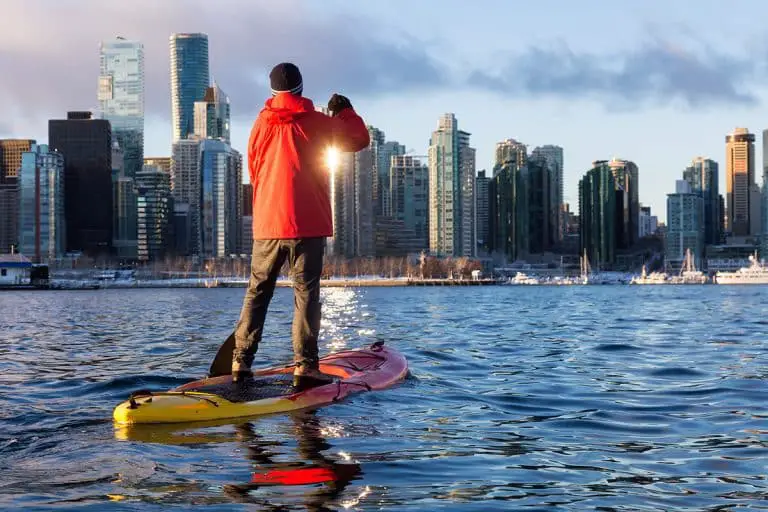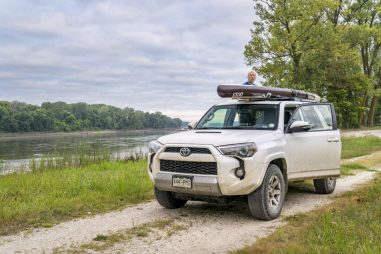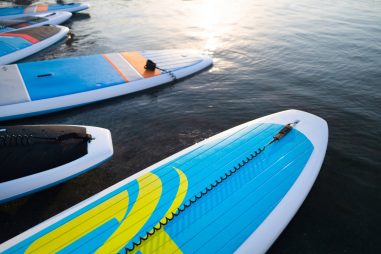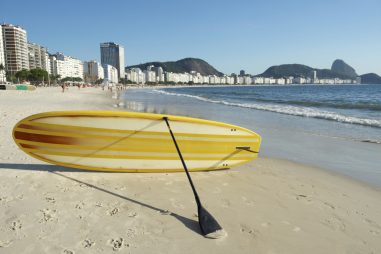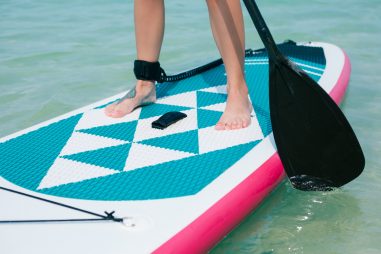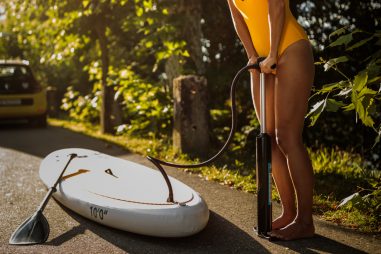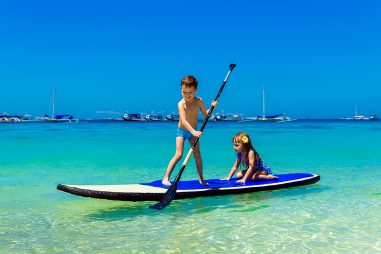The position and pace of the wind have a significant impact on this sport. Any time you go paddle boarding, check the weather forecast to ensure the wind is blowing in the right direction. In general, beginner paddle boarders prefer warmer temperatures around 85°F (29.5°C) or higher. Intermediate paddlers prefer at a temperature of 80°F (26.5°C). Around 70°F (21°C) are favored by advance paddlers, and lastly, expert paddle boarders prefer 60°F (15°C).
Can You Paddle Board When It Is Windy?
In the world of paddle boarding, sailing in windy weather is perilous. Some paddlers do not risk cruising to the oceans when it is windy, yet some paddlers like its thrill. The most difficult challenge to deal with is a crosswind. A crosswind can make your board unstable and makes you put more effort into paddling.
Paddling in the wind is achievable by tacking or zigzagging upwind then side-downwind. Coming to a stance by stepping one foot back will also help add more strength in paddling. Finally, looking for cliffs and comfortable places to rest is necessary for contingency purposes. Though paddling in windy conditions is challenging, these measures will make paddle boarding uncomplicated.
How Do You Paddle Board With Wind?
Off-shore winds, or wind rushing from the shore either out to sea or into the bay or river you’re paddling in, can be erratic. If you’re new to standup paddling, stay close to the shore and avoid paddling on windy days. However, if you find yourself in high winds, you can do a few things to keep on your board and handle the situation:
- Get low: Lower your body in the paddle board for balance. Then, your body can act as a sail.
- Move your hands in the paddle: Place both of your hands on the opposite side of the paddle. This way, you can paddle to either side of the board. You can also hold the paddle into a choke stroke for a wider grip.
- Make sure your body weight is forward: When your body is forward, this will stop the wind from getting to the nose of the paddleboard and the wind from getting underneath it, especially if you have a wide-rounded nose board.
- Change your paddle stroke: A shorter paddle stroke will be more effective when paddling into the wind. Let the board glide in the water, and it is similar to pulling your board for the water and not pushing it.
- Don’t stop paddling: When your body is all set, do not stop paddling, and you can now feel the thrill of the adventure. If all else fails, drop to your knees, or you can paddle with your hands. And, of course, always be mindful of the wind and be prepared.
What Wind Speed Is Good for Paddle Boarding?
Generally, beginners should paddle at 15 knots at the most (less than 27 kph), while more experienced and seasoned paddlers find that 20 – 25 knots are best (around 37 – 46 kph). When the winds exceed 15 knots (28-36 km/h), small waves and whitecaps can begin to form. So, suspend paddle boarding and reschedule your trip whether you’re a beginner or even an advanced paddler.
Make sure to follow precautions and keep yourself safe. Winds of 25 knots or more are dangerous for all kinds of paddlers. There are plenty of websites where you can check weather conditions for a more enjoyable and safe paddle boarding experience.
What Wind Is Too Strong for Paddle Boarding?
A wind that is too strong for paddle boarding is 25 knots. It is discouraged to paddleboard in this condition because this will be dangerous. In case you want to paddleboard smoothly, review the weather forecast frequently as it does change.
A beginner paddler will find it challenging to drive at 12 knots or 13.8 mph depending on the strength of the paddler, type of paddleboard, and area. It is suggested to have other activities like hiking or running since this is dangerous.
Can You Paddle Board in the Winter?
Paddling in the winter is absolutely possible. However, some do avoid paddle boarding in cold weather, despite its excellent benefits. Exploring the wonders and scenery of the natural world can be admired during this season. The oceans are not crammed with people, and you can appreciate how vast the water is.
You must wear the appropriate outerwear. For this cold weather, you’ll need a cold-water wetsuit (5/4 thickness), a wool jacket for underlayers, waterproof gloves, a beanie, a ski mask, a wood sweater, and waterproof boots. Paddle boarding needs some planning in order to be a memorable activity. Bringing hot beverages, water, a leash, and extra clothing is also good.
How Do You Paddle Board in the Winter?
Paddle boarding is something you will love, especially in this kind of season. Preparation is vital to be equipped and ready for this adventure. Paddling in the winter has seen a lot of recognition recently, outside of its cult following. Paddling on a calm lake in the middle of a peaceful, snowy wonderland is undeniably enticing.
Winter paddle boarding is fun but challenging. The cold can cut through layers and exhaust paddlers, even with proper clothing. Therefore, setting goals is just as critical as preparation. Here are the tips for winter paddle boarding:
- Dress appropriately, and wear the right gear
- Wear neoprene booty, socks, and gloves
- Wear a hat
- Wear waterproof body dry suit and thermal layers underneath
- Don’t forget to bring your lifejacket
- Bring the leash
- Stay close to shore
- Hydrate with water or tea
- Know your surroundings. How fast, how long you will be out, conditions, boat traffic
- It’s always a good idea to let someone know where you are going too
- Get out there and have fun
How Cold Is Too Cold for Paddle Boarding?
The ideal temperature for paddle boarding is different for every person. Some can do up to 10°F while some 20°F or 30°F. It is fantastic to feel the snow and paddle board during this season. If you think it is too risky, it is better not to go paddle boarding.
Beginners should avoid this kind of weather. Being aware of the dangers during cold weather is necessary for safety measures. Always make sure you are prepared, wearing the right clothes, and having the right gear. Check and double-check the weather updates just to be sure. It is better to be safe than sorry.
Can You Paddle Board in the Fall?
SUP is commonly classified as a summer sport, but this couldn’t be further from the truth; you can definitely paddle board in the fall. Unbeknownst to many, paddle boarding in the fall is perfect—wind and water condition-wise.
During these months, the winds begin to calm down, and the waters are glassy, making paddling and gliding easier. With bigger, smoother waves at several of your favorite surf spots, this is also the perfect time for surfing. As always, remember to check the weather forecast, dress appropriately, and make sure you are hydrated.
Can You Paddle Board in the Rain?
Rain isn’t a threat in and of itself. The only disadvantage of rain is that it will turn your board slippery. The real challenge is dealing with the cold or windy weather that always accompanies rain. When planning a paddle boarding trip, it’s essential to keep in mind the temperature. A summer rainstorm, for example, will keep you wet but will not put you at risk of hypothermia.
However, if it starts to pour heavily, go back to shore and reschedule your trip, as this can be dangerous. You will face choppy waters will make it much more difficult to maintain your balance on your paddle board. The water will sway the board as the wind kicks up and rain pours down. Consider your safety first!

